Assessing Climate Change Impact on Indigenous Australians' Land Policy
VerifiedAdded on 2019/10/30
|10
|2277
|163
Report
AI Summary
This report investigates the profound impact of climate change on Indigenous Australian Aboriginals, highlighting their vulnerability due to geographic settlement patterns and the importance of land rights. The study explores the evolution of Indigenous land rights in Australia, starting with the Yirrkala bark petition and the Aboriginal Land Rights Act 1983. It examines the shortcomings in the implementation of the ALRA and addresses the research question of whether Aboriginals should prove a systematic common law Aboriginal title. The report reviews existing literature on climate change's effects on Indigenous communities, including rising sea levels and the impact on archaeological sites. It also discusses the influence of the mining industry on Aboriginal lands and the protections offered by the Aboriginal Land Rights Act 1976. The methodology involves secondary data analysis, content analysis of regulations, and an interdisciplinary approach considering law, environmental science, and management to develop recommendations for improving Aboriginal land protection policies. The study aims to provide solutions within the legal framework for the betterment of Aboriginals and amendments in legislative policies.
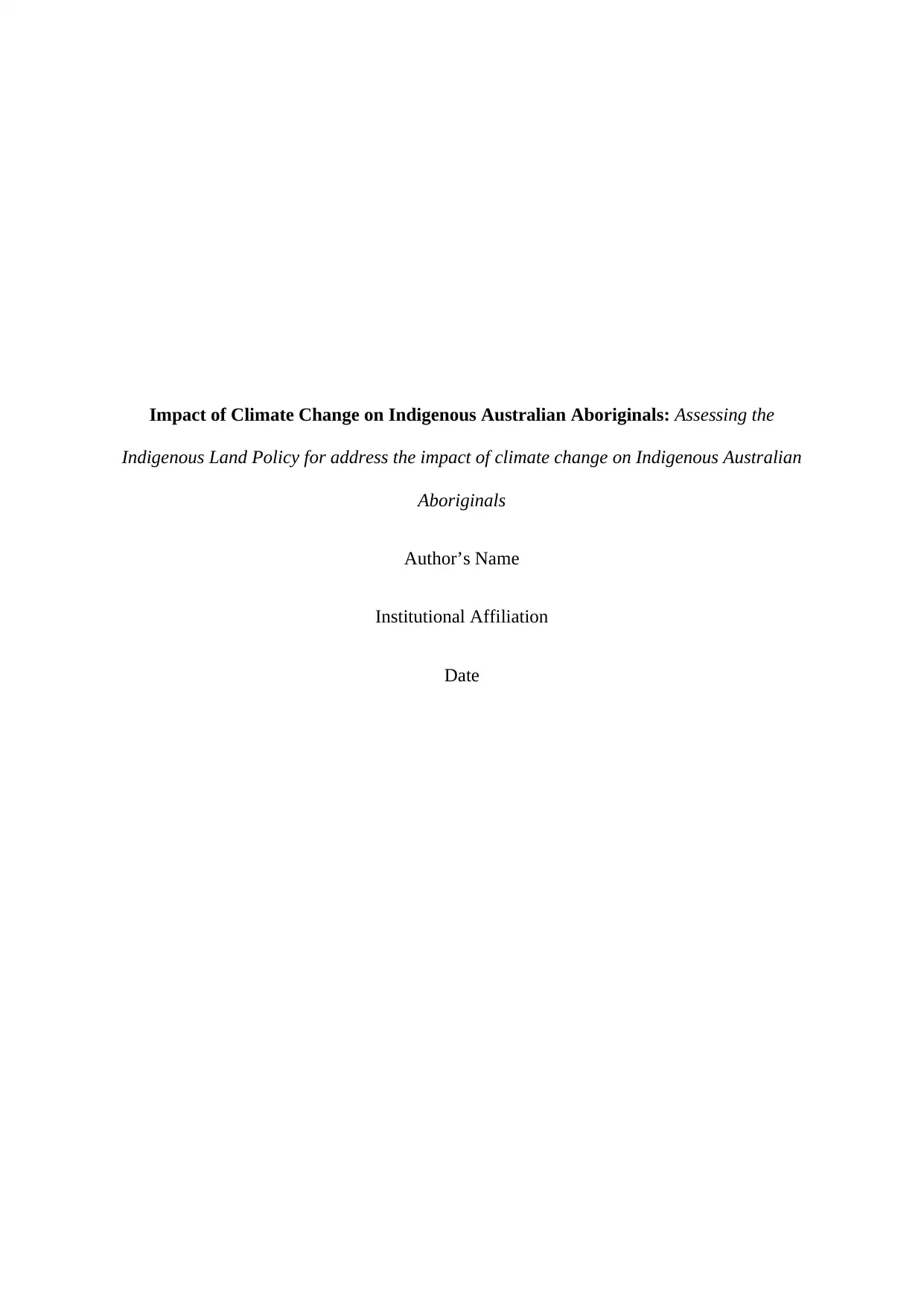
Impact of Climate Change on Indigenous Australian Aboriginals: Assessing the
Indigenous Land Policy for address the impact of climate change on Indigenous Australian
Aboriginals
Author’s Name
Institutional Affiliation
Date
Indigenous Land Policy for address the impact of climate change on Indigenous Australian
Aboriginals
Author’s Name
Institutional Affiliation
Date
Paraphrase This Document
Need a fresh take? Get an instant paraphrase of this document with our AI Paraphraser
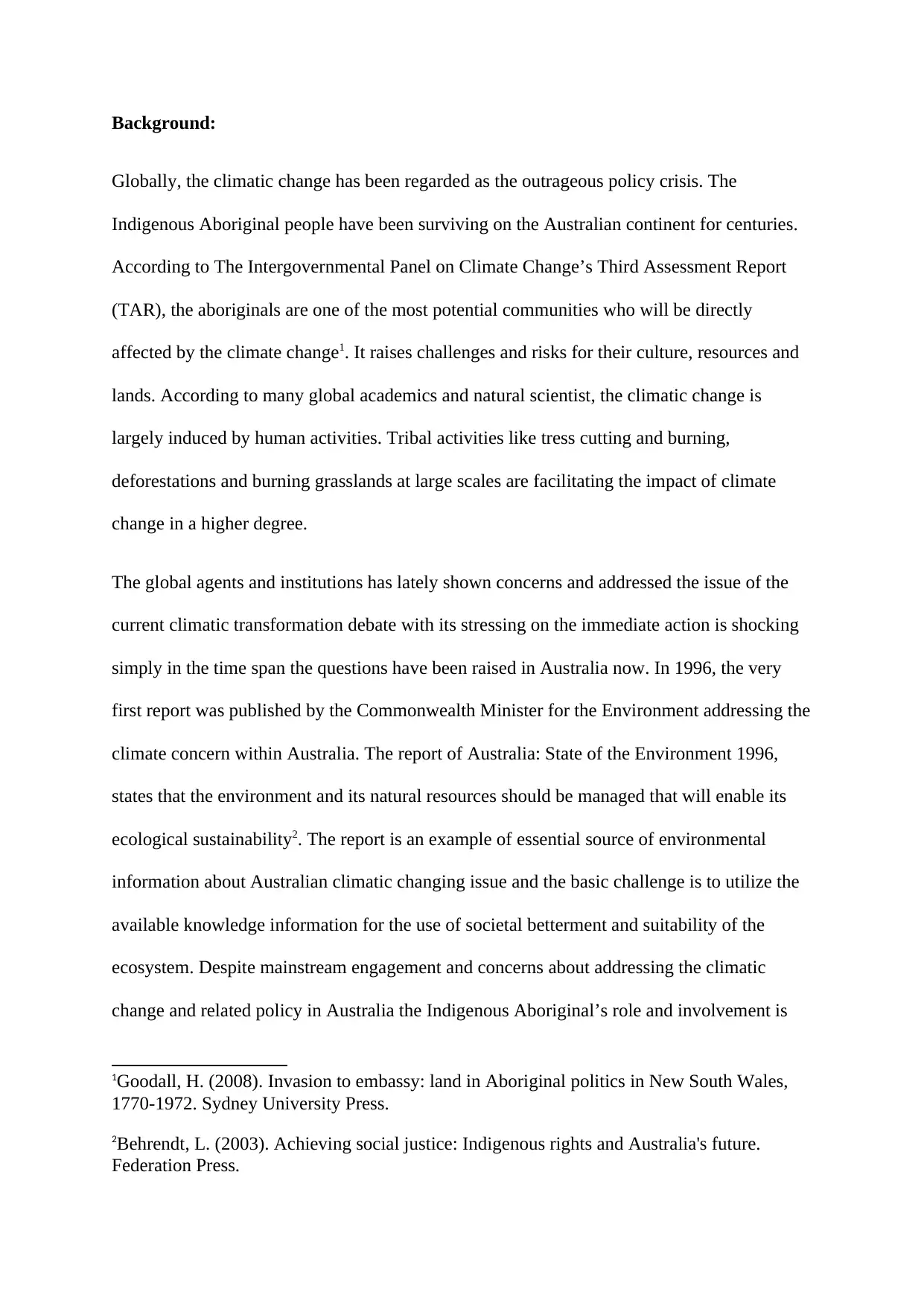
Background:
Globally, the climatic change has been regarded as the outrageous policy crisis. The
Indigenous Aboriginal people have been surviving on the Australian continent for centuries.
According to The Intergovernmental Panel on Climate Change’s Third Assessment Report
(TAR), the aboriginals are one of the most potential communities who will be directly
affected by the climate change1. It raises challenges and risks for their culture, resources and
lands. According to many global academics and natural scientist, the climatic change is
largely induced by human activities. Tribal activities like tress cutting and burning,
deforestations and burning grasslands at large scales are facilitating the impact of climate
change in a higher degree.
The global agents and institutions has lately shown concerns and addressed the issue of the
current climatic transformation debate with its stressing on the immediate action is shocking
simply in the time span the questions have been raised in Australia now. In 1996, the very
first report was published by the Commonwealth Minister for the Environment addressing the
climate concern within Australia. The report of Australia: State of the Environment 1996,
states that the environment and its natural resources should be managed that will enable its
ecological sustainability2. The report is an example of essential source of environmental
information about Australian climatic changing issue and the basic challenge is to utilize the
available knowledge information for the use of societal betterment and suitability of the
ecosystem. Despite mainstream engagement and concerns about addressing the climatic
change and related policy in Australia the Indigenous Aboriginal’s role and involvement is
1Goodall, H. (2008). Invasion to embassy: land in Aboriginal politics in New South Wales,
1770-1972. Sydney University Press.
2Behrendt, L. (2003). Achieving social justice: Indigenous rights and Australia's future.
Federation Press.
Globally, the climatic change has been regarded as the outrageous policy crisis. The
Indigenous Aboriginal people have been surviving on the Australian continent for centuries.
According to The Intergovernmental Panel on Climate Change’s Third Assessment Report
(TAR), the aboriginals are one of the most potential communities who will be directly
affected by the climate change1. It raises challenges and risks for their culture, resources and
lands. According to many global academics and natural scientist, the climatic change is
largely induced by human activities. Tribal activities like tress cutting and burning,
deforestations and burning grasslands at large scales are facilitating the impact of climate
change in a higher degree.
The global agents and institutions has lately shown concerns and addressed the issue of the
current climatic transformation debate with its stressing on the immediate action is shocking
simply in the time span the questions have been raised in Australia now. In 1996, the very
first report was published by the Commonwealth Minister for the Environment addressing the
climate concern within Australia. The report of Australia: State of the Environment 1996,
states that the environment and its natural resources should be managed that will enable its
ecological sustainability2. The report is an example of essential source of environmental
information about Australian climatic changing issue and the basic challenge is to utilize the
available knowledge information for the use of societal betterment and suitability of the
ecosystem. Despite mainstream engagement and concerns about addressing the climatic
change and related policy in Australia the Indigenous Aboriginal’s role and involvement is
1Goodall, H. (2008). Invasion to embassy: land in Aboriginal politics in New South Wales,
1770-1972. Sydney University Press.
2Behrendt, L. (2003). Achieving social justice: Indigenous rights and Australia's future.
Federation Press.
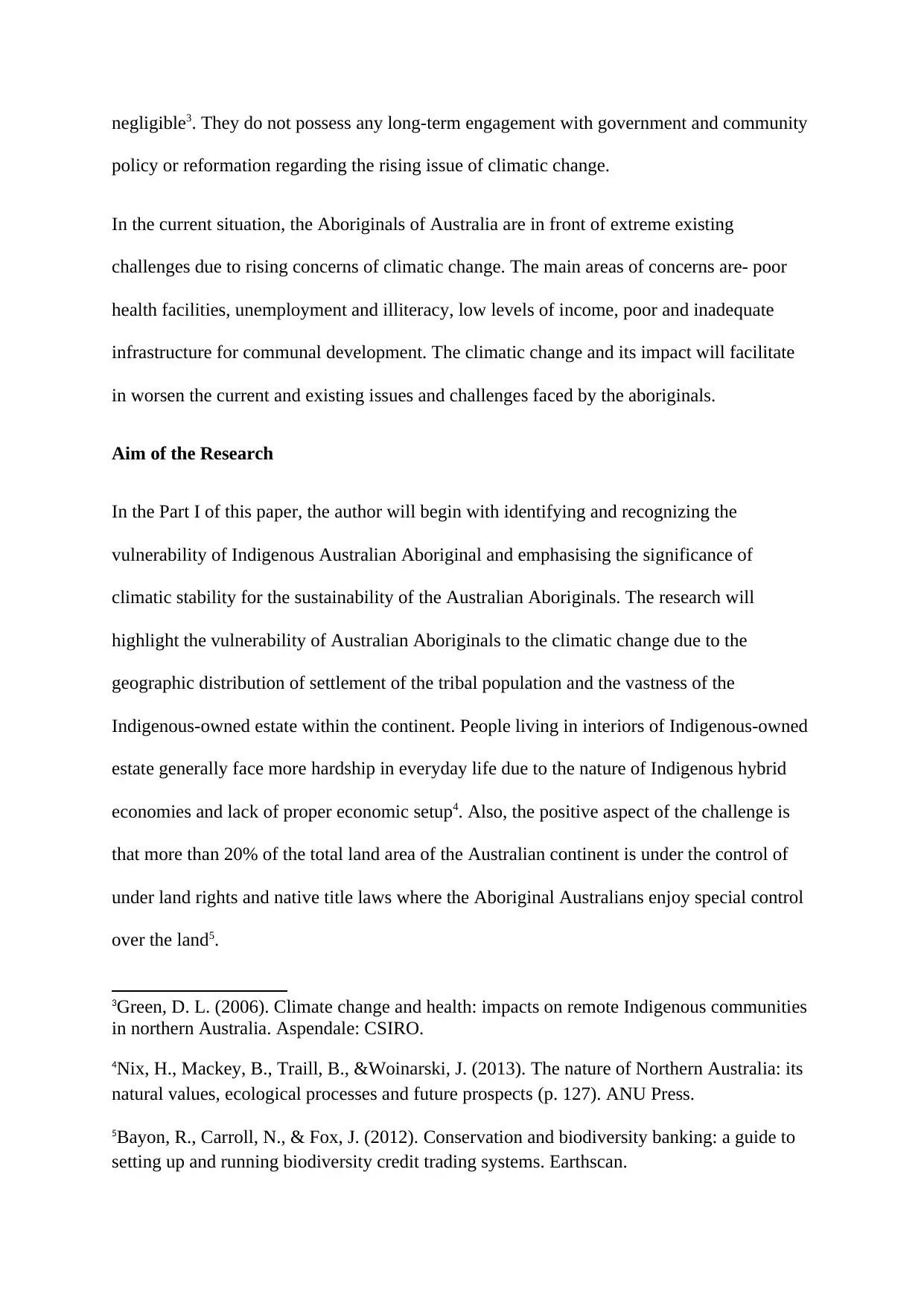
negligible3. They do not possess any long-term engagement with government and community
policy or reformation regarding the rising issue of climatic change.
In the current situation, the Aboriginals of Australia are in front of extreme existing
challenges due to rising concerns of climatic change. The main areas of concerns are- poor
health facilities, unemployment and illiteracy, low levels of income, poor and inadequate
infrastructure for communal development. The climatic change and its impact will facilitate
in worsen the current and existing issues and challenges faced by the aboriginals.
Aim of the Research
In the Part I of this paper, the author will begin with identifying and recognizing the
vulnerability of Indigenous Australian Aboriginal and emphasising the significance of
climatic stability for the sustainability of the Australian Aboriginals. The research will
highlight the vulnerability of Australian Aboriginals to the climatic change due to the
geographic distribution of settlement of the tribal population and the vastness of the
Indigenous-owned estate within the continent. People living in interiors of Indigenous-owned
estate generally face more hardship in everyday life due to the nature of Indigenous hybrid
economies and lack of proper economic setup4. Also, the positive aspect of the challenge is
that more than 20% of the total land area of the Australian continent is under the control of
under land rights and native title laws where the Aboriginal Australians enjoy special control
over the land5.
3Green, D. L. (2006). Climate change and health: impacts on remote Indigenous communities
in northern Australia. Aspendale: CSIRO.
4Nix, H., Mackey, B., Traill, B., &Woinarski, J. (2013). The nature of Northern Australia: its
natural values, ecological processes and future prospects (p. 127). ANU Press.
5Bayon, R., Carroll, N., & Fox, J. (2012). Conservation and biodiversity banking: a guide to
setting up and running biodiversity credit trading systems. Earthscan.
policy or reformation regarding the rising issue of climatic change.
In the current situation, the Aboriginals of Australia are in front of extreme existing
challenges due to rising concerns of climatic change. The main areas of concerns are- poor
health facilities, unemployment and illiteracy, low levels of income, poor and inadequate
infrastructure for communal development. The climatic change and its impact will facilitate
in worsen the current and existing issues and challenges faced by the aboriginals.
Aim of the Research
In the Part I of this paper, the author will begin with identifying and recognizing the
vulnerability of Indigenous Australian Aboriginal and emphasising the significance of
climatic stability for the sustainability of the Australian Aboriginals. The research will
highlight the vulnerability of Australian Aboriginals to the climatic change due to the
geographic distribution of settlement of the tribal population and the vastness of the
Indigenous-owned estate within the continent. People living in interiors of Indigenous-owned
estate generally face more hardship in everyday life due to the nature of Indigenous hybrid
economies and lack of proper economic setup4. Also, the positive aspect of the challenge is
that more than 20% of the total land area of the Australian continent is under the control of
under land rights and native title laws where the Aboriginal Australians enjoy special control
over the land5.
3Green, D. L. (2006). Climate change and health: impacts on remote Indigenous communities
in northern Australia. Aspendale: CSIRO.
4Nix, H., Mackey, B., Traill, B., &Woinarski, J. (2013). The nature of Northern Australia: its
natural values, ecological processes and future prospects (p. 127). ANU Press.
5Bayon, R., Carroll, N., & Fox, J. (2012). Conservation and biodiversity banking: a guide to
setting up and running biodiversity credit trading systems. Earthscan.
⊘ This is a preview!⊘
Do you want full access?
Subscribe today to unlock all pages.

Trusted by 1+ million students worldwide
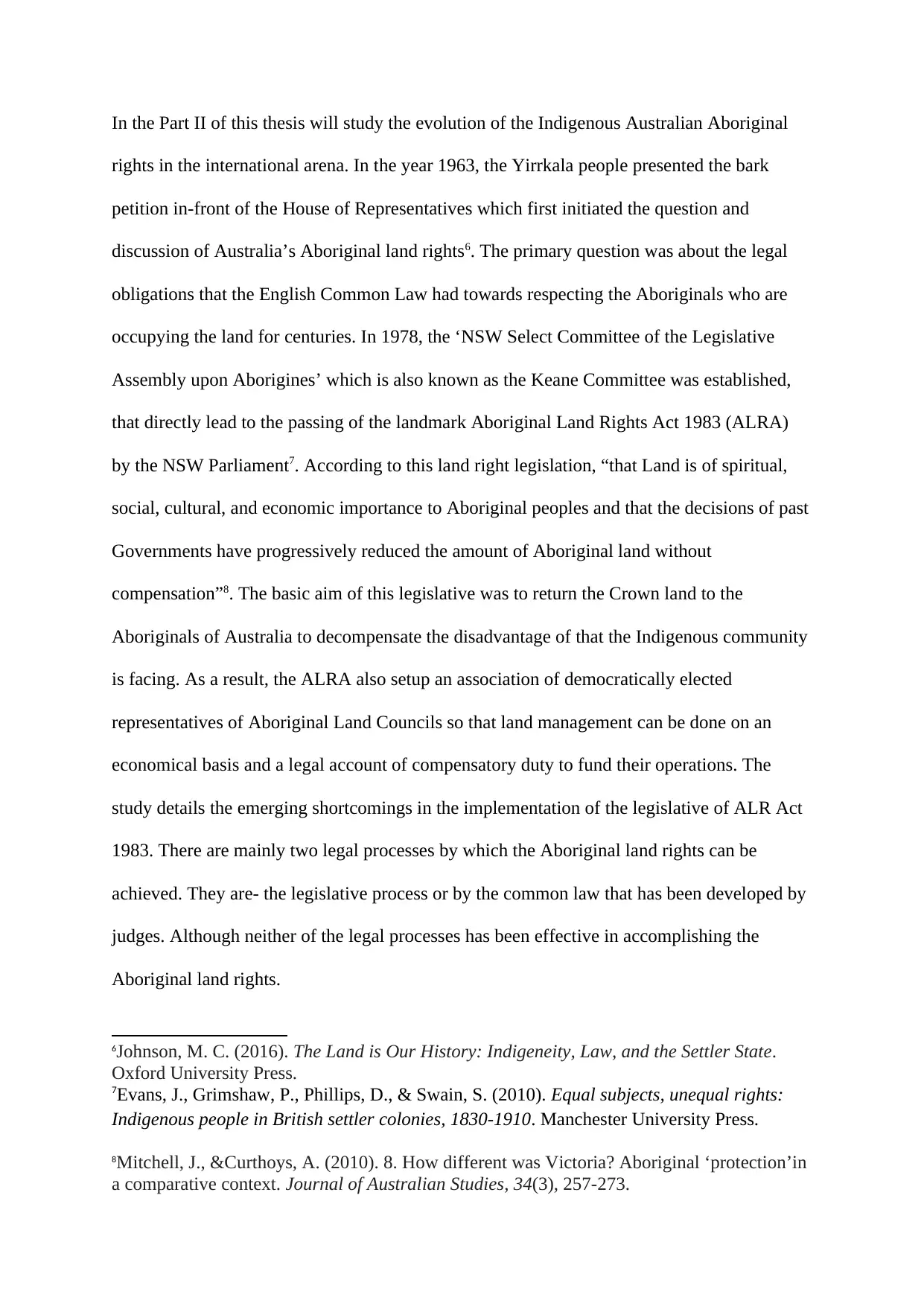
In the Part II of this thesis will study the evolution of the Indigenous Australian Aboriginal
rights in the international arena. In the year 1963, the Yirrkala people presented the bark
petition in-front of the House of Representatives which first initiated the question and
discussion of Australia’s Aboriginal land rights6. The primary question was about the legal
obligations that the English Common Law had towards respecting the Aboriginals who are
occupying the land for centuries. In 1978, the ‘NSW Select Committee of the Legislative
Assembly upon Aborigines’ which is also known as the Keane Committee was established,
that directly lead to the passing of the landmark Aboriginal Land Rights Act 1983 (ALRA)
by the NSW Parliament7. According to this land right legislation, “that Land is of spiritual,
social, cultural, and economic importance to Aboriginal peoples and that the decisions of past
Governments have progressively reduced the amount of Aboriginal land without
compensation”8. The basic aim of this legislative was to return the Crown land to the
Aboriginals of Australia to decompensate the disadvantage of that the Indigenous community
is facing. As a result, the ALRA also setup an association of democratically elected
representatives of Aboriginal Land Councils so that land management can be done on an
economical basis and a legal account of compensatory duty to fund their operations. The
study details the emerging shortcomings in the implementation of the legislative of ALR Act
1983. There are mainly two legal processes by which the Aboriginal land rights can be
achieved. They are- the legislative process or by the common law that has been developed by
judges. Although neither of the legal processes has been effective in accomplishing the
Aboriginal land rights.
6Johnson, M. C. (2016). The Land is Our History: Indigeneity, Law, and the Settler State.
Oxford University Press.
7Evans, J., Grimshaw, P., Phillips, D., & Swain, S. (2010). Equal subjects, unequal rights:
Indigenous people in British settler colonies, 1830-1910. Manchester University Press.
8Mitchell, J., &Curthoys, A. (2010). 8. How different was Victoria? Aboriginal ‘protection’in
a comparative context. Journal of Australian Studies, 34(3), 257-273.
rights in the international arena. In the year 1963, the Yirrkala people presented the bark
petition in-front of the House of Representatives which first initiated the question and
discussion of Australia’s Aboriginal land rights6. The primary question was about the legal
obligations that the English Common Law had towards respecting the Aboriginals who are
occupying the land for centuries. In 1978, the ‘NSW Select Committee of the Legislative
Assembly upon Aborigines’ which is also known as the Keane Committee was established,
that directly lead to the passing of the landmark Aboriginal Land Rights Act 1983 (ALRA)
by the NSW Parliament7. According to this land right legislation, “that Land is of spiritual,
social, cultural, and economic importance to Aboriginal peoples and that the decisions of past
Governments have progressively reduced the amount of Aboriginal land without
compensation”8. The basic aim of this legislative was to return the Crown land to the
Aboriginals of Australia to decompensate the disadvantage of that the Indigenous community
is facing. As a result, the ALRA also setup an association of democratically elected
representatives of Aboriginal Land Councils so that land management can be done on an
economical basis and a legal account of compensatory duty to fund their operations. The
study details the emerging shortcomings in the implementation of the legislative of ALR Act
1983. There are mainly two legal processes by which the Aboriginal land rights can be
achieved. They are- the legislative process or by the common law that has been developed by
judges. Although neither of the legal processes has been effective in accomplishing the
Aboriginal land rights.
6Johnson, M. C. (2016). The Land is Our History: Indigeneity, Law, and the Settler State.
Oxford University Press.
7Evans, J., Grimshaw, P., Phillips, D., & Swain, S. (2010). Equal subjects, unequal rights:
Indigenous people in British settler colonies, 1830-1910. Manchester University Press.
8Mitchell, J., &Curthoys, A. (2010). 8. How different was Victoria? Aboriginal ‘protection’in
a comparative context. Journal of Australian Studies, 34(3), 257-273.
Paraphrase This Document
Need a fresh take? Get an instant paraphrase of this document with our AI Paraphraser
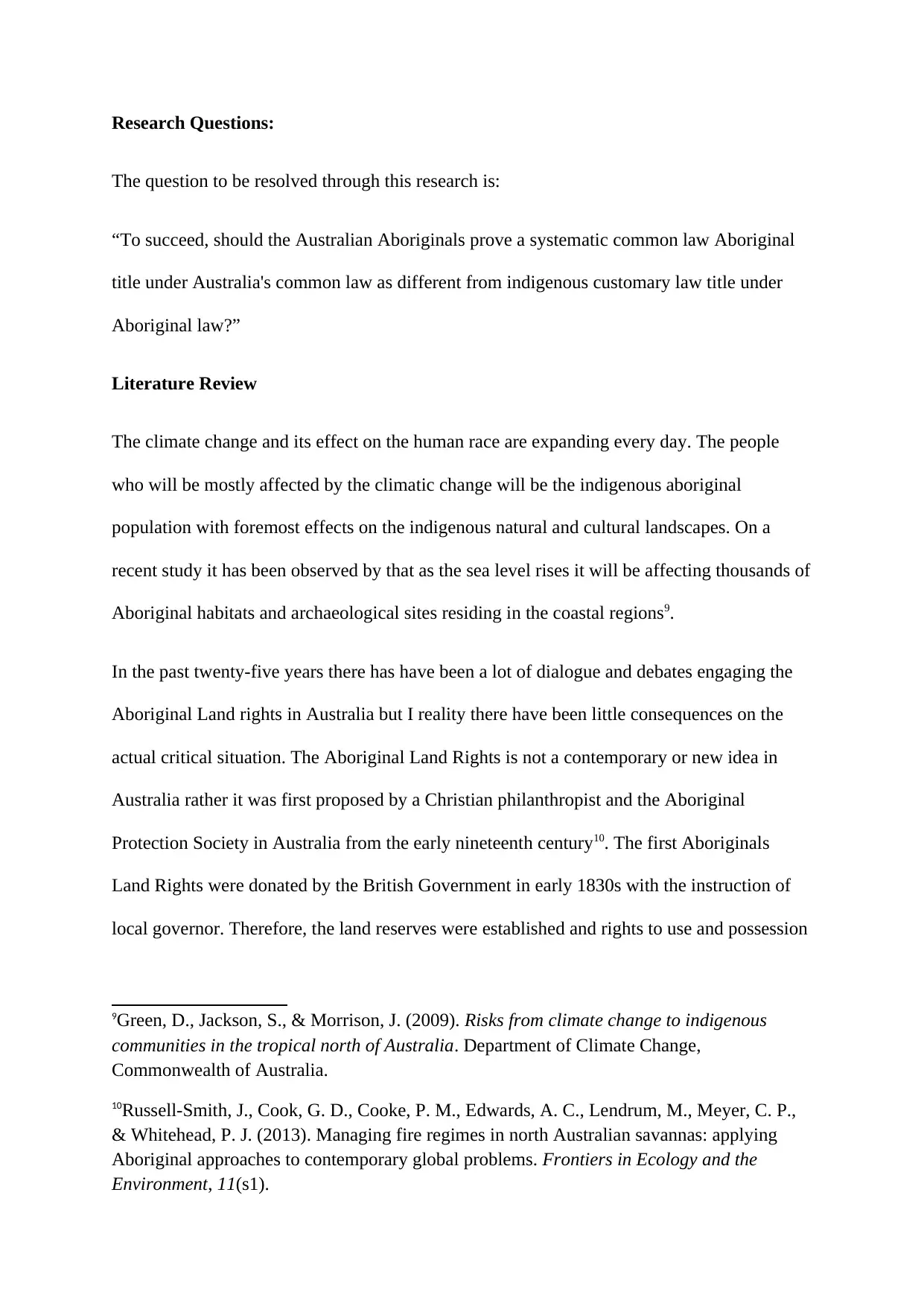
Research Questions:
The question to be resolved through this research is:
“To succeed, should the Australian Aboriginals prove a systematic common law Aboriginal
title under Australia's common law as different from indigenous customary law title under
Aboriginal law?”
Literature Review
The climate change and its effect on the human race are expanding every day. The people
who will be mostly affected by the climatic change will be the indigenous aboriginal
population with foremost effects on the indigenous natural and cultural landscapes. On a
recent study it has been observed by that as the sea level rises it will be affecting thousands of
Aboriginal habitats and archaeological sites residing in the coastal regions9.
In the past twenty-five years there has have been a lot of dialogue and debates engaging the
Aboriginal Land rights in Australia but I reality there have been little consequences on the
actual critical situation. The Aboriginal Land Rights is not a contemporary or new idea in
Australia rather it was first proposed by a Christian philanthropist and the Aboriginal
Protection Society in Australia from the early nineteenth century10. The first Aboriginals
Land Rights were donated by the British Government in early 1830s with the instruction of
local governor. Therefore, the land reserves were established and rights to use and possession
9Green, D., Jackson, S., & Morrison, J. (2009). Risks from climate change to indigenous
communities in the tropical north of Australia. Department of Climate Change,
Commonwealth of Australia.
10Russell-Smith, J., Cook, G. D., Cooke, P. M., Edwards, A. C., Lendrum, M., Meyer, C. P.,
& Whitehead, P. J. (2013). Managing fire regimes in north Australian savannas: applying
Aboriginal approaches to contemporary global problems. Frontiers in Ecology and the
Environment, 11(s1).
The question to be resolved through this research is:
“To succeed, should the Australian Aboriginals prove a systematic common law Aboriginal
title under Australia's common law as different from indigenous customary law title under
Aboriginal law?”
Literature Review
The climate change and its effect on the human race are expanding every day. The people
who will be mostly affected by the climatic change will be the indigenous aboriginal
population with foremost effects on the indigenous natural and cultural landscapes. On a
recent study it has been observed by that as the sea level rises it will be affecting thousands of
Aboriginal habitats and archaeological sites residing in the coastal regions9.
In the past twenty-five years there has have been a lot of dialogue and debates engaging the
Aboriginal Land rights in Australia but I reality there have been little consequences on the
actual critical situation. The Aboriginal Land Rights is not a contemporary or new idea in
Australia rather it was first proposed by a Christian philanthropist and the Aboriginal
Protection Society in Australia from the early nineteenth century10. The first Aboriginals
Land Rights were donated by the British Government in early 1830s with the instruction of
local governor. Therefore, the land reserves were established and rights to use and possession
9Green, D., Jackson, S., & Morrison, J. (2009). Risks from climate change to indigenous
communities in the tropical north of Australia. Department of Climate Change,
Commonwealth of Australia.
10Russell-Smith, J., Cook, G. D., Cooke, P. M., Edwards, A. C., Lendrum, M., Meyer, C. P.,
& Whitehead, P. J. (2013). Managing fire regimes in north Australian savannas: applying
Aboriginal approaches to contemporary global problems. Frontiers in Ecology and the
Environment, 11(s1).
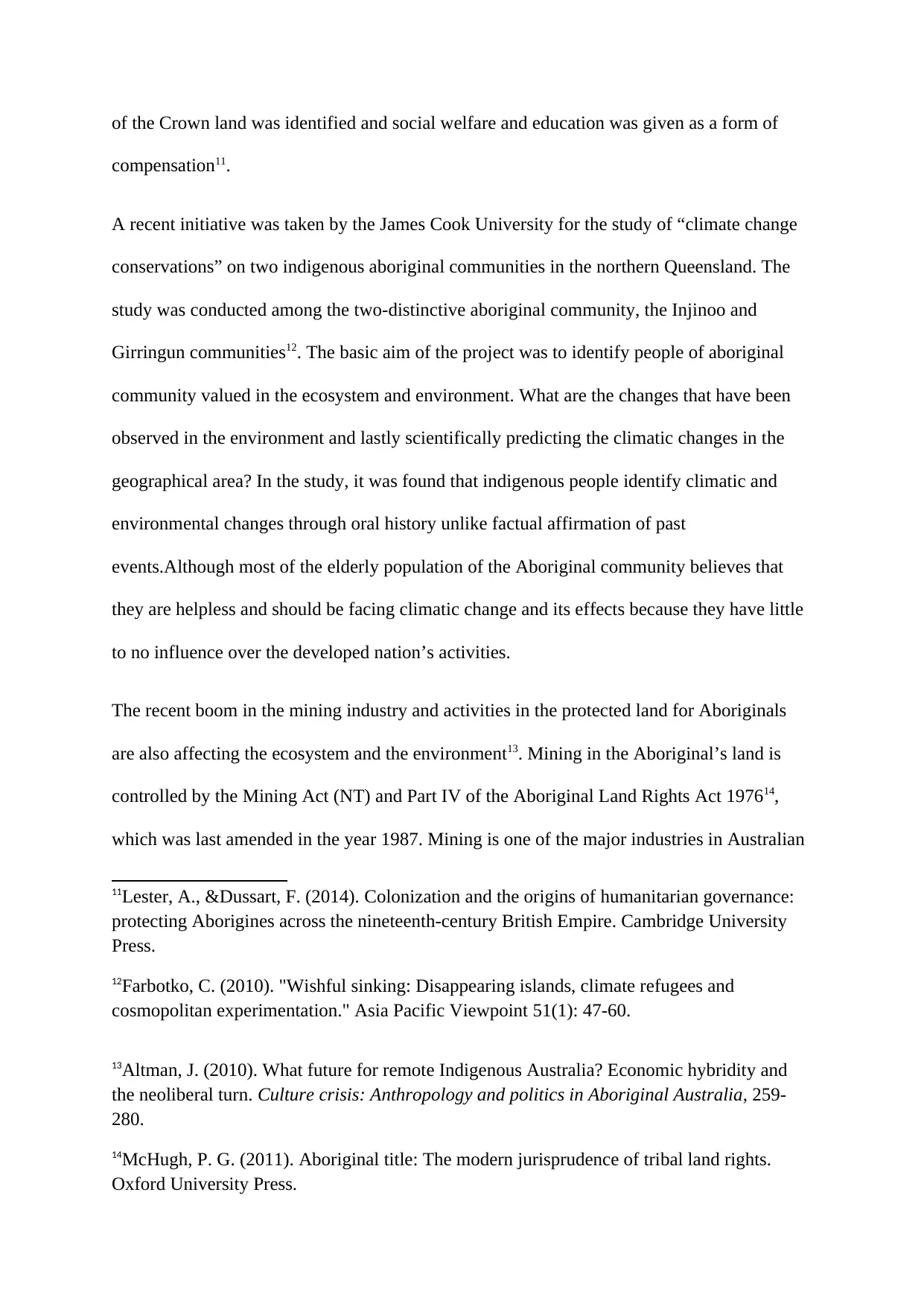
of the Crown land was identified and social welfare and education was given as a form of
compensation11.
A recent initiative was taken by the James Cook University for the study of “climate change
conservations” on two indigenous aboriginal communities in the northern Queensland. The
study was conducted among the two-distinctive aboriginal community, the Injinoo and
Girringun communities12. The basic aim of the project was to identify people of aboriginal
community valued in the ecosystem and environment. What are the changes that have been
observed in the environment and lastly scientifically predicting the climatic changes in the
geographical area? In the study, it was found that indigenous people identify climatic and
environmental changes through oral history unlike factual affirmation of past
events.Although most of the elderly population of the Aboriginal community believes that
they are helpless and should be facing climatic change and its effects because they have little
to no influence over the developed nation’s activities.
The recent boom in the mining industry and activities in the protected land for Aboriginals
are also affecting the ecosystem and the environment13. Mining in the Aboriginal’s land is
controlled by the Mining Act (NT) and Part IV of the Aboriginal Land Rights Act 197614,
which was last amended in the year 1987. Mining is one of the major industries in Australian
11Lester, A., &Dussart, F. (2014). Colonization and the origins of humanitarian governance:
protecting Aborigines across the nineteenth-century British Empire. Cambridge University
Press.
12Farbotko, C. (2010). "Wishful sinking: Disappearing islands, climate refugees and
cosmopolitan experimentation." Asia Pacific Viewpoint 51(1): 47-60.
13Altman, J. (2010). What future for remote Indigenous Australia? Economic hybridity and
the neoliberal turn. Culture crisis: Anthropology and politics in Aboriginal Australia, 259-
280.
14McHugh, P. G. (2011). Aboriginal title: The modern jurisprudence of tribal land rights.
Oxford University Press.
compensation11.
A recent initiative was taken by the James Cook University for the study of “climate change
conservations” on two indigenous aboriginal communities in the northern Queensland. The
study was conducted among the two-distinctive aboriginal community, the Injinoo and
Girringun communities12. The basic aim of the project was to identify people of aboriginal
community valued in the ecosystem and environment. What are the changes that have been
observed in the environment and lastly scientifically predicting the climatic changes in the
geographical area? In the study, it was found that indigenous people identify climatic and
environmental changes through oral history unlike factual affirmation of past
events.Although most of the elderly population of the Aboriginal community believes that
they are helpless and should be facing climatic change and its effects because they have little
to no influence over the developed nation’s activities.
The recent boom in the mining industry and activities in the protected land for Aboriginals
are also affecting the ecosystem and the environment13. Mining in the Aboriginal’s land is
controlled by the Mining Act (NT) and Part IV of the Aboriginal Land Rights Act 197614,
which was last amended in the year 1987. Mining is one of the major industries in Australian
11Lester, A., &Dussart, F. (2014). Colonization and the origins of humanitarian governance:
protecting Aborigines across the nineteenth-century British Empire. Cambridge University
Press.
12Farbotko, C. (2010). "Wishful sinking: Disappearing islands, climate refugees and
cosmopolitan experimentation." Asia Pacific Viewpoint 51(1): 47-60.
13Altman, J. (2010). What future for remote Indigenous Australia? Economic hybridity and
the neoliberal turn. Culture crisis: Anthropology and politics in Aboriginal Australia, 259-
280.
14McHugh, P. G. (2011). Aboriginal title: The modern jurisprudence of tribal land rights.
Oxford University Press.
⊘ This is a preview!⊘
Do you want full access?
Subscribe today to unlock all pages.

Trusted by 1+ million students worldwide
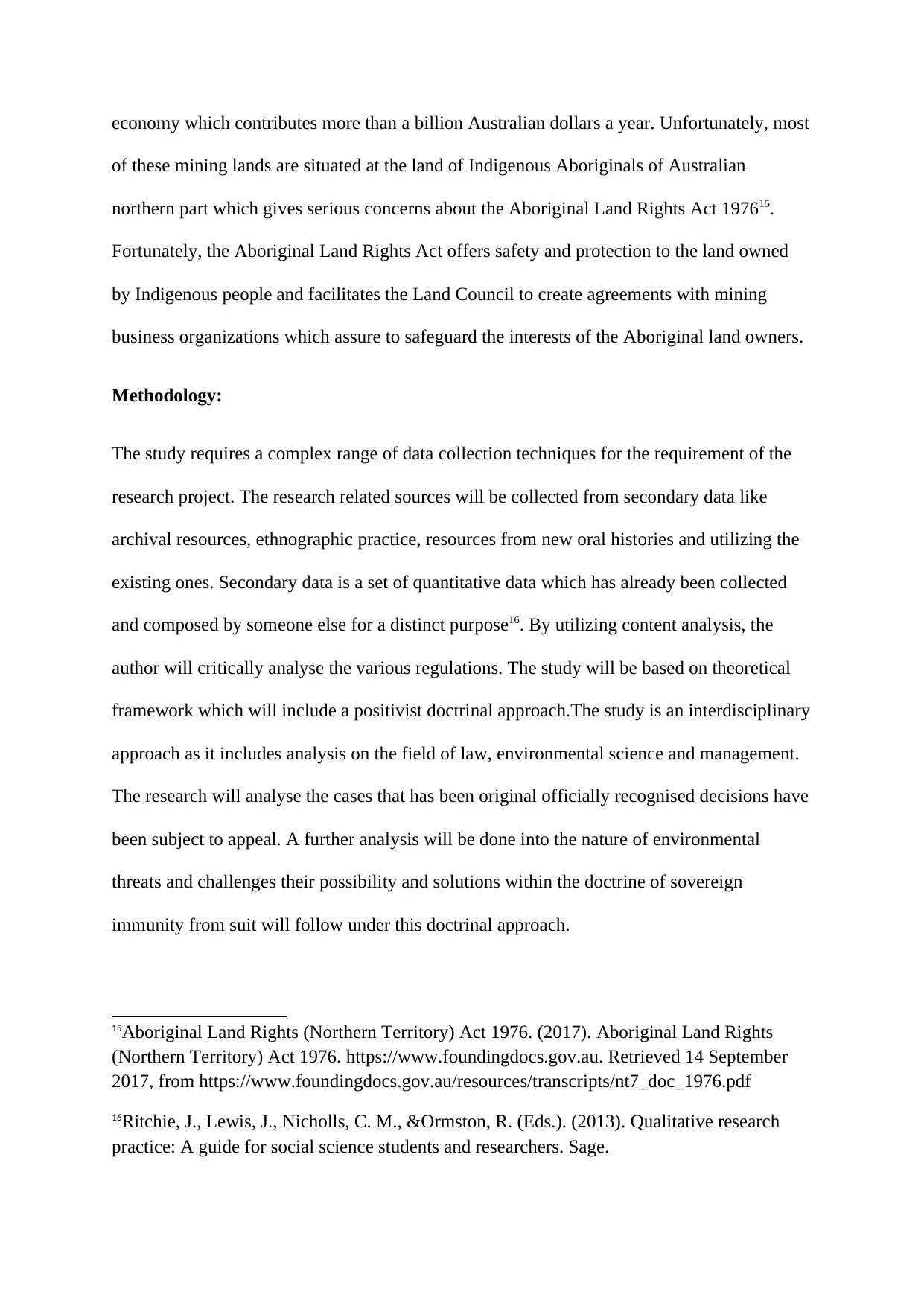
economy which contributes more than a billion Australian dollars a year. Unfortunately, most
of these mining lands are situated at the land of Indigenous Aboriginals of Australian
northern part which gives serious concerns about the Aboriginal Land Rights Act 197615.
Fortunately, the Aboriginal Land Rights Act offers safety and protection to the land owned
by Indigenous people and facilitates the Land Council to create agreements with mining
business organizations which assure to safeguard the interests of the Aboriginal land owners.
Methodology:
The study requires a complex range of data collection techniques for the requirement of the
research project. The research related sources will be collected from secondary data like
archival resources, ethnographic practice, resources from new oral histories and utilizing the
existing ones. Secondary data is a set of quantitative data which has already been collected
and composed by someone else for a distinct purpose16. By utilizing content analysis, the
author will critically analyse the various regulations. The study will be based on theoretical
framework which will include a positivist doctrinal approach.The study is an interdisciplinary
approach as it includes analysis on the field of law, environmental science and management.
The research will analyse the cases that has been original officially recognised decisions have
been subject to appeal. A further analysis will be done into the nature of environmental
threats and challenges their possibility and solutions within the doctrine of sovereign
immunity from suit will follow under this doctrinal approach.
15Aboriginal Land Rights (Northern Territory) Act 1976. (2017). Aboriginal Land Rights
(Northern Territory) Act 1976. https://www.foundingdocs.gov.au. Retrieved 14 September
2017, from https://www.foundingdocs.gov.au/resources/transcripts/nt7_doc_1976.pdf
16Ritchie, J., Lewis, J., Nicholls, C. M., &Ormston, R. (Eds.). (2013). Qualitative research
practice: A guide for social science students and researchers. Sage.
of these mining lands are situated at the land of Indigenous Aboriginals of Australian
northern part which gives serious concerns about the Aboriginal Land Rights Act 197615.
Fortunately, the Aboriginal Land Rights Act offers safety and protection to the land owned
by Indigenous people and facilitates the Land Council to create agreements with mining
business organizations which assure to safeguard the interests of the Aboriginal land owners.
Methodology:
The study requires a complex range of data collection techniques for the requirement of the
research project. The research related sources will be collected from secondary data like
archival resources, ethnographic practice, resources from new oral histories and utilizing the
existing ones. Secondary data is a set of quantitative data which has already been collected
and composed by someone else for a distinct purpose16. By utilizing content analysis, the
author will critically analyse the various regulations. The study will be based on theoretical
framework which will include a positivist doctrinal approach.The study is an interdisciplinary
approach as it includes analysis on the field of law, environmental science and management.
The research will analyse the cases that has been original officially recognised decisions have
been subject to appeal. A further analysis will be done into the nature of environmental
threats and challenges their possibility and solutions within the doctrine of sovereign
immunity from suit will follow under this doctrinal approach.
15Aboriginal Land Rights (Northern Territory) Act 1976. (2017). Aboriginal Land Rights
(Northern Territory) Act 1976. https://www.foundingdocs.gov.au. Retrieved 14 September
2017, from https://www.foundingdocs.gov.au/resources/transcripts/nt7_doc_1976.pdf
16Ritchie, J., Lewis, J., Nicholls, C. M., &Ormston, R. (Eds.). (2013). Qualitative research
practice: A guide for social science students and researchers. Sage.
Paraphrase This Document
Need a fresh take? Get an instant paraphrase of this document with our AI Paraphraser
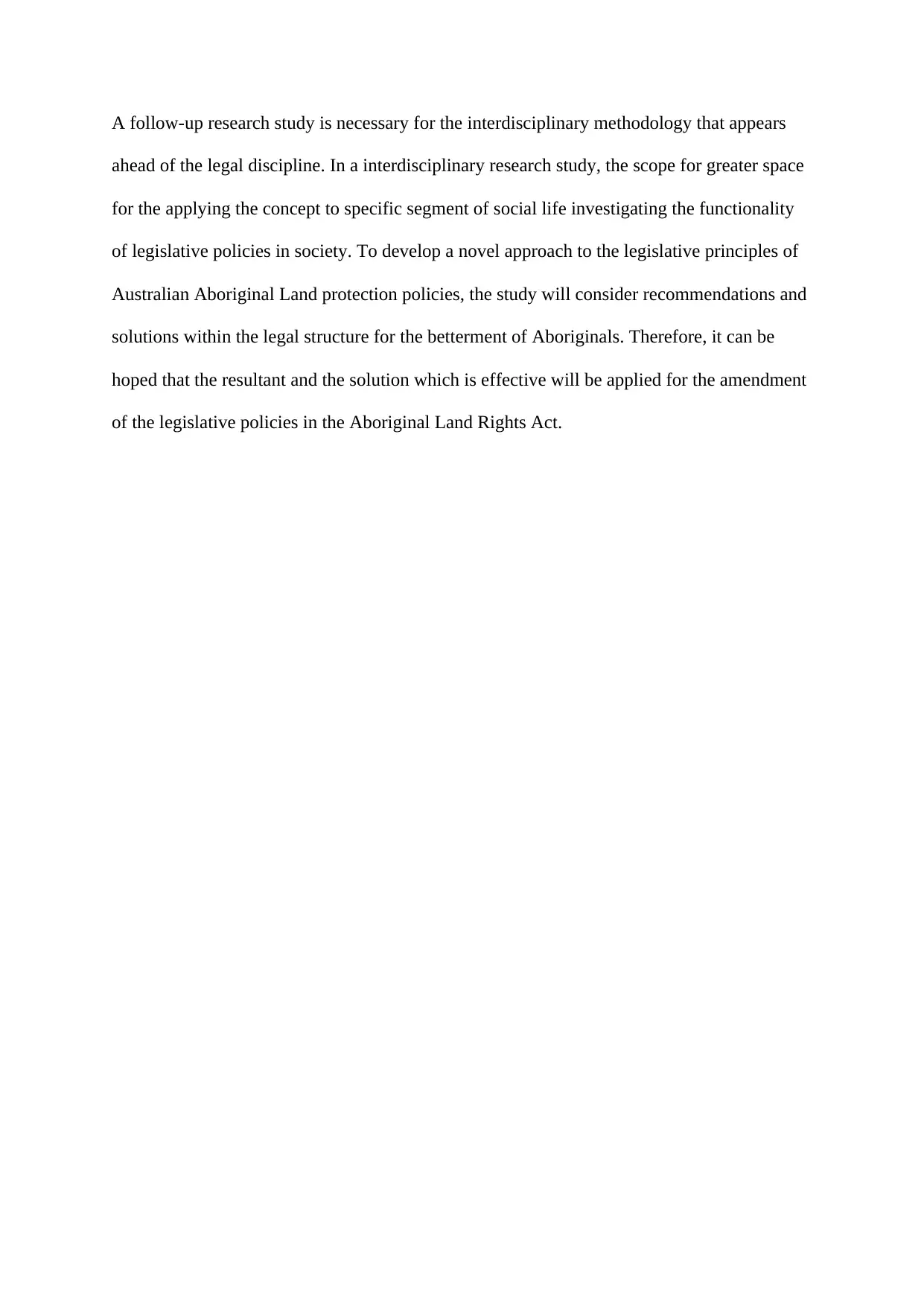
A follow-up research study is necessary for the interdisciplinary methodology that appears
ahead of the legal discipline. In a interdisciplinary research study, the scope for greater space
for the applying the concept to specific segment of social life investigating the functionality
of legislative policies in society. To develop a novel approach to the legislative principles of
Australian Aboriginal Land protection policies, the study will consider recommendations and
solutions within the legal structure for the betterment of Aboriginals. Therefore, it can be
hoped that the resultant and the solution which is effective will be applied for the amendment
of the legislative policies in the Aboriginal Land Rights Act.
ahead of the legal discipline. In a interdisciplinary research study, the scope for greater space
for the applying the concept to specific segment of social life investigating the functionality
of legislative policies in society. To develop a novel approach to the legislative principles of
Australian Aboriginal Land protection policies, the study will consider recommendations and
solutions within the legal structure for the betterment of Aboriginals. Therefore, it can be
hoped that the resultant and the solution which is effective will be applied for the amendment
of the legislative policies in the Aboriginal Land Rights Act.
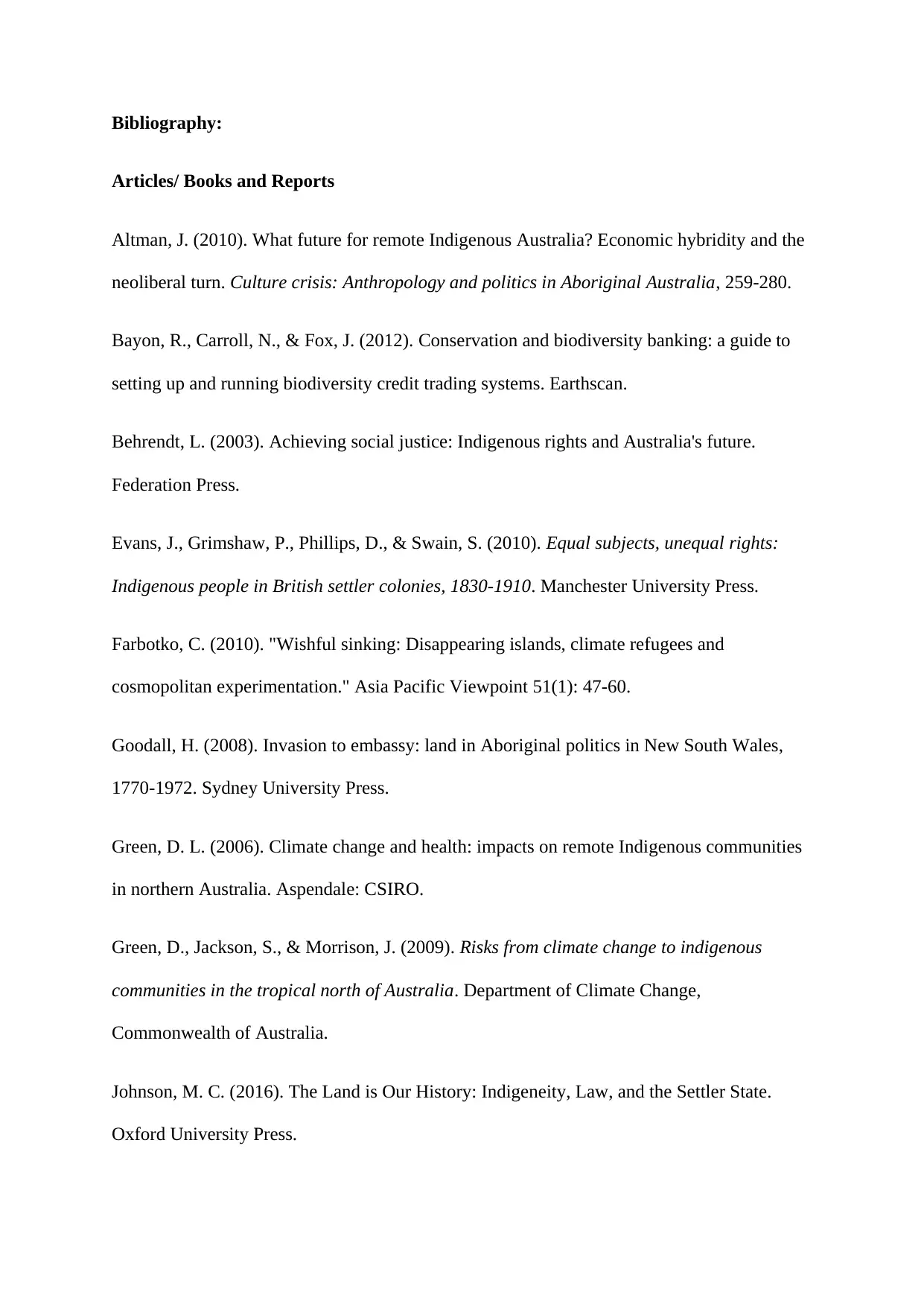
Bibliography:
Articles/ Books and Reports
Altman, J. (2010). What future for remote Indigenous Australia? Economic hybridity and the
neoliberal turn. Culture crisis: Anthropology and politics in Aboriginal Australia, 259-280.
Bayon, R., Carroll, N., & Fox, J. (2012). Conservation and biodiversity banking: a guide to
setting up and running biodiversity credit trading systems. Earthscan.
Behrendt, L. (2003). Achieving social justice: Indigenous rights and Australia's future.
Federation Press.
Evans, J., Grimshaw, P., Phillips, D., & Swain, S. (2010). Equal subjects, unequal rights:
Indigenous people in British settler colonies, 1830-1910. Manchester University Press.
Farbotko, C. (2010). "Wishful sinking: Disappearing islands, climate refugees and
cosmopolitan experimentation." Asia Pacific Viewpoint 51(1): 47-60.
Goodall, H. (2008). Invasion to embassy: land in Aboriginal politics in New South Wales,
1770-1972. Sydney University Press.
Green, D. L. (2006). Climate change and health: impacts on remote Indigenous communities
in northern Australia. Aspendale: CSIRO.
Green, D., Jackson, S., & Morrison, J. (2009). Risks from climate change to indigenous
communities in the tropical north of Australia. Department of Climate Change,
Commonwealth of Australia.
Johnson, M. C. (2016). The Land is Our History: Indigeneity, Law, and the Settler State.
Oxford University Press.
Articles/ Books and Reports
Altman, J. (2010). What future for remote Indigenous Australia? Economic hybridity and the
neoliberal turn. Culture crisis: Anthropology and politics in Aboriginal Australia, 259-280.
Bayon, R., Carroll, N., & Fox, J. (2012). Conservation and biodiversity banking: a guide to
setting up and running biodiversity credit trading systems. Earthscan.
Behrendt, L. (2003). Achieving social justice: Indigenous rights and Australia's future.
Federation Press.
Evans, J., Grimshaw, P., Phillips, D., & Swain, S. (2010). Equal subjects, unequal rights:
Indigenous people in British settler colonies, 1830-1910. Manchester University Press.
Farbotko, C. (2010). "Wishful sinking: Disappearing islands, climate refugees and
cosmopolitan experimentation." Asia Pacific Viewpoint 51(1): 47-60.
Goodall, H. (2008). Invasion to embassy: land in Aboriginal politics in New South Wales,
1770-1972. Sydney University Press.
Green, D. L. (2006). Climate change and health: impacts on remote Indigenous communities
in northern Australia. Aspendale: CSIRO.
Green, D., Jackson, S., & Morrison, J. (2009). Risks from climate change to indigenous
communities in the tropical north of Australia. Department of Climate Change,
Commonwealth of Australia.
Johnson, M. C. (2016). The Land is Our History: Indigeneity, Law, and the Settler State.
Oxford University Press.
⊘ This is a preview!⊘
Do you want full access?
Subscribe today to unlock all pages.

Trusted by 1+ million students worldwide
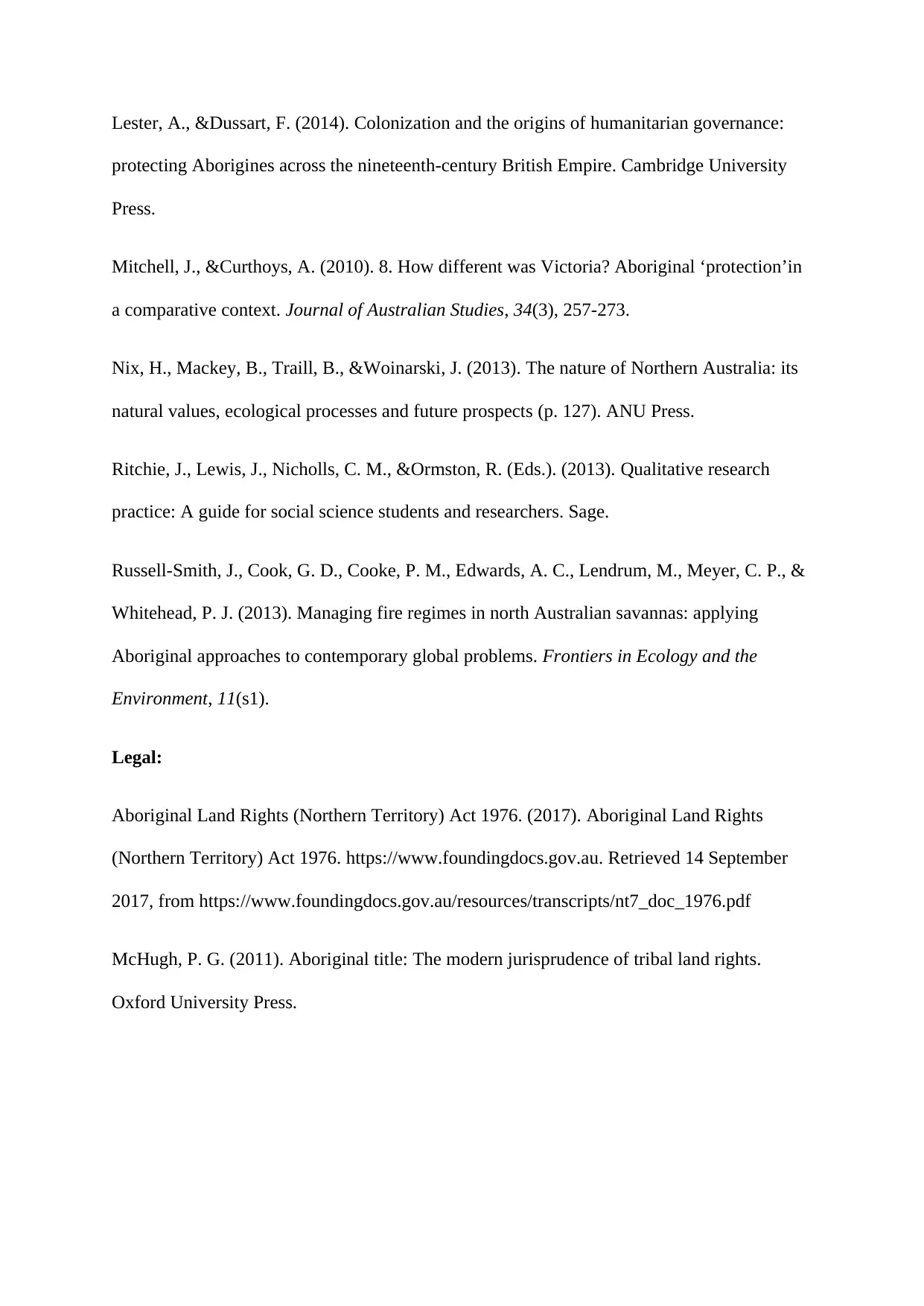
Lester, A., &Dussart, F. (2014). Colonization and the origins of humanitarian governance:
protecting Aborigines across the nineteenth-century British Empire. Cambridge University
Press.
Mitchell, J., &Curthoys, A. (2010). 8. How different was Victoria? Aboriginal ‘protection’in
a comparative context. Journal of Australian Studies, 34(3), 257-273.
Nix, H., Mackey, B., Traill, B., &Woinarski, J. (2013). The nature of Northern Australia: its
natural values, ecological processes and future prospects (p. 127). ANU Press.
Ritchie, J., Lewis, J., Nicholls, C. M., &Ormston, R. (Eds.). (2013). Qualitative research
practice: A guide for social science students and researchers. Sage.
Russell-Smith, J., Cook, G. D., Cooke, P. M., Edwards, A. C., Lendrum, M., Meyer, C. P., &
Whitehead, P. J. (2013). Managing fire regimes in north Australian savannas: applying
Aboriginal approaches to contemporary global problems. Frontiers in Ecology and the
Environment, 11(s1).
Legal:
Aboriginal Land Rights (Northern Territory) Act 1976. (2017). Aboriginal Land Rights
(Northern Territory) Act 1976. https://www.foundingdocs.gov.au. Retrieved 14 September
2017, from https://www.foundingdocs.gov.au/resources/transcripts/nt7_doc_1976.pdf
McHugh, P. G. (2011). Aboriginal title: The modern jurisprudence of tribal land rights.
Oxford University Press.
protecting Aborigines across the nineteenth-century British Empire. Cambridge University
Press.
Mitchell, J., &Curthoys, A. (2010). 8. How different was Victoria? Aboriginal ‘protection’in
a comparative context. Journal of Australian Studies, 34(3), 257-273.
Nix, H., Mackey, B., Traill, B., &Woinarski, J. (2013). The nature of Northern Australia: its
natural values, ecological processes and future prospects (p. 127). ANU Press.
Ritchie, J., Lewis, J., Nicholls, C. M., &Ormston, R. (Eds.). (2013). Qualitative research
practice: A guide for social science students and researchers. Sage.
Russell-Smith, J., Cook, G. D., Cooke, P. M., Edwards, A. C., Lendrum, M., Meyer, C. P., &
Whitehead, P. J. (2013). Managing fire regimes in north Australian savannas: applying
Aboriginal approaches to contemporary global problems. Frontiers in Ecology and the
Environment, 11(s1).
Legal:
Aboriginal Land Rights (Northern Territory) Act 1976. (2017). Aboriginal Land Rights
(Northern Territory) Act 1976. https://www.foundingdocs.gov.au. Retrieved 14 September
2017, from https://www.foundingdocs.gov.au/resources/transcripts/nt7_doc_1976.pdf
McHugh, P. G. (2011). Aboriginal title: The modern jurisprudence of tribal land rights.
Oxford University Press.
1 out of 10
Related Documents
Your All-in-One AI-Powered Toolkit for Academic Success.
+13062052269
info@desklib.com
Available 24*7 on WhatsApp / Email
![[object Object]](/_next/static/media/star-bottom.7253800d.svg)
Unlock your academic potential
Copyright © 2020–2025 A2Z Services. All Rights Reserved. Developed and managed by ZUCOL.





